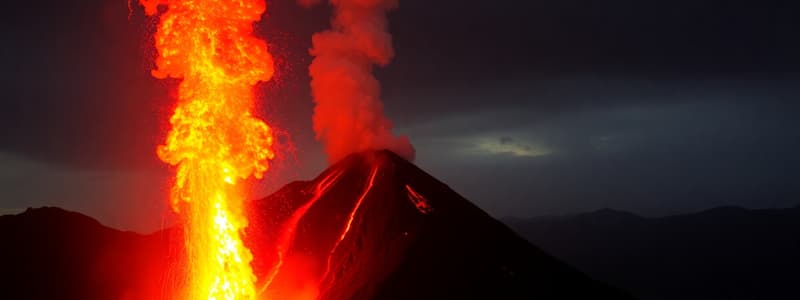Podcast
Questions and Answers
What is the primary driving force behind a volcanic eruption?
What is the primary driving force behind a volcanic eruption?
- The buildup of pressure from rising magma. (correct)
- The release of sulfuric acid aerosols.
- The cooling of lava on the Earth's surface.
- The interaction of water with volcanic heat.
Which gas is the most abundant in volcanic eruptions?
Which gas is the most abundant in volcanic eruptions?
- Sulfur Dioxide
- Carbon Dioxide
- Water Vapor (correct)
- Hydrochloric Acid
How does sulfur dioxide released from volcanoes affect global warming?
How does sulfur dioxide released from volcanoes affect global warming?
- It has no effect on global warming.
- It contributes to global warming by trapping heat.
- It decreases global warming by reflecting sunlight. (correct)
- It causes acid rain.
Why is carbon dioxide considered a greenhouse gas?
Why is carbon dioxide considered a greenhouse gas?
What immediate safety measure should people take if a volcanic eruption occurs nearby?
What immediate safety measure should people take if a volcanic eruption occurs nearby?
Flashcards
Volcanoes
Volcanoes
Mountainous rock formations that emit gases and materials when they erupt.
Volcanic Eruption
Volcanic Eruption
The release of magma, gases, and other materials from a volcano due to increasing pressure.
Water Vapor
Water Vapor
Steam, the most abundant volcanic gas, formed when heat interacts with nearby water sources.
Carbon Dioxide
Carbon Dioxide
Signup and view all the flashcards
Sulfur Dioxide
Sulfur Dioxide
Signup and view all the flashcards
Study Notes
- Volcanoes are rock formations that emit gases and materials during eruptions.
Volcanic Eruption Steps
- Magma builds up in a chamber beneath the volcano.
- Pressure increases as magma rises in chambers below vents.
- Magma heat and pressure reach a breaking point.
- Magma presses through vents and releases into the atmosphere and onto the earth's surface.
- Dangerous gases release as a side effect.
- Carbon dioxide and sulfur dioxide inhalation lead to health problems.
- GasesReleased can cause suffocation.
Components of Volcanic Eruptions
- Lava.
- Gases
- water vapor
- carbon dioxide
- sulfur dioxide
- Other gases, in smaller amounts.
Release of Volcanic Gases
- Gases are dissolved in magma, brought to the surface.
- Magma turns into lava and releases on the surface.
- Gases leave the magma and enter the atmosphere.
Water Vapor
- It is steam, the product of heat interacting with water.
- It is the most abundant gas during an eruption.
- Eruptions launch water vapor into the stratosphere, incorporating it into clouds.
- Volcanoes and emissions contribute to the water cycle.
- It can influence future watering of soil enriched by cooled magma.
- Emissions warm Earth's surface.
- Water vapor in the atmosphere traps heat, increasing global warming.
Carbon Dioxide
- It is a harmful gas expelled through eruptions.
- It has no odor or color.
- It is noncombustible.
- It is a greenhouse gas, heavier than air, accumulating in low-lying areas.
- High concentrations can be fatal to humans.
- It affects the warming of Earth's surface, leading to global warming.
- Absorption of heat rising from the earth's surface occurs.
- Energy is trapped in the atmosphere.
- A small amount of energy reflects to the earth, increasing the Earth's temperature.
Sulfur Dioxide
- It is a harmful gas released during eruptions.
- It creates sulfuric acid aerosols in the stratosphere.
- These aerosols reflect sunlight and heat into space.
- They may decrease global warming and climate change.
- Negative effects on the earth do occur
- It contributes to acid rain.
- It mixes with water in the atmosphere.
- Rain contains remnants of sulfur dioxide and other acids.
Other Volcanic Gases
- Hydrogen sulfide and hydrochloric acid release in trace amounts.
- Both acids harm human health.
- They damage the respiratory system and irritate the eyes.
- Other effects: headaches, nausea, somatic disorders.
Characteristics and Effects of Volcanic Gases
- Presence in the stratosphere and atmosphere.
- Harm to human and animal health.
- Contribution to the progression of climate change.
Precautions
- Avoid low-level areas near volcanoes.
- Disable ventilation systems if you live near a volcano.
- Turn off ventilation systems during an eruption.
- Stay inside, even if the home is damaged.
- Use cloth masks outdoors.
- Close and seal windows, doors, and openings.
- Close car windows and do not use air conditioning.
- Avoid water sources that may be contaminated by volcanic gases.
- River water can interact and mix with polluting gases.
Studying That Suits You
Use AI to generate personalized quizzes and flashcards to suit your learning preferences.




